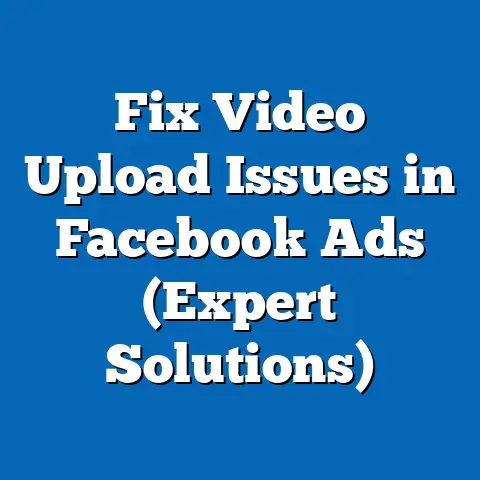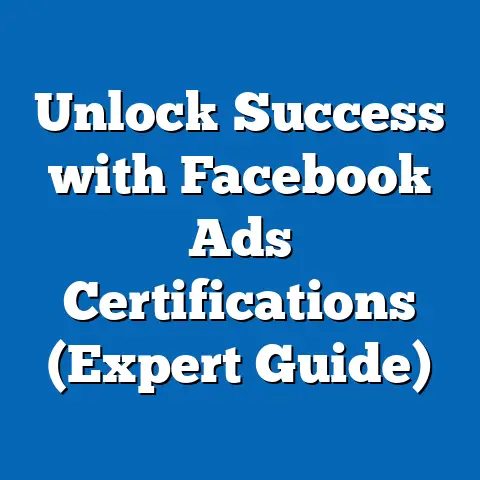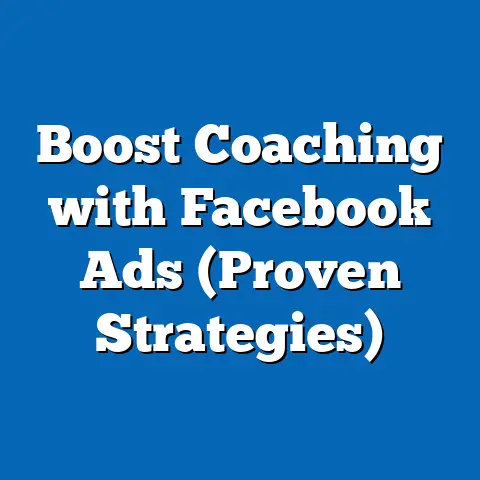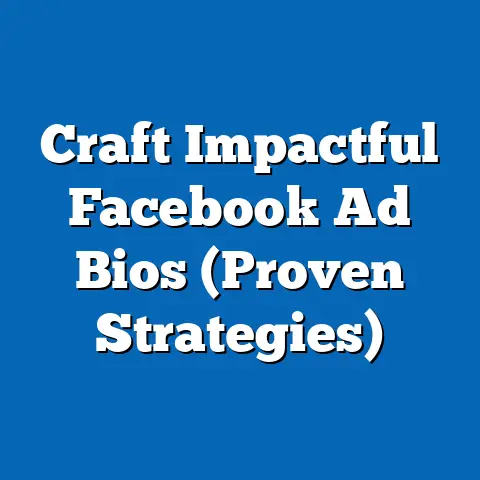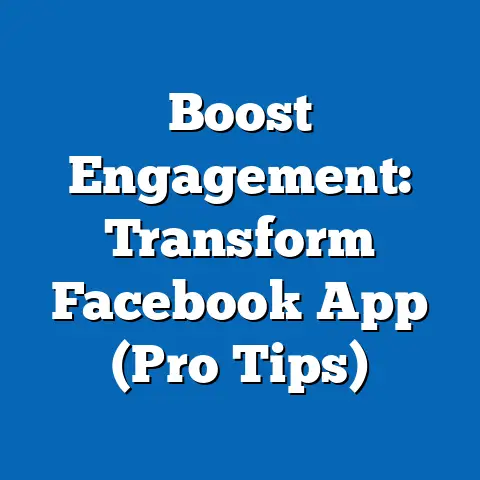Unlock Facebook Ad Specs for Success (Pro Strategies)
Have you ever felt like you’re shouting into a void with your Facebook ads? You’ve got a great product, a compelling offer, and a decent budget, yet your ads barely make a ripple. It’s frustrating, I know, I’ve been there! Did you know that 90% of Facebook users are connected to a business through the platform? Yet, many advertisers struggle to craft ads that truly resonate. What if the secret to unlocking the full potential of Facebook advertising lies in understanding its ad specs?
For years, I struggled to get my Facebook ads to perform as well as I wanted. I was spending money, but not seeing the return I expected. It felt like I was missing something fundamental. Then, I stumbled upon a deep dive into Facebook’s ad specifications, and it was a game-changer. Suddenly, things started to click. I realized that the platform is incredibly particular about what it allows and how it presents ads. Ignoring these specifications is like trying to fit a square peg into a round hole – it simply won’t work, and you’ll waste time and money in the process.
In this guide, I’m going to share everything I’ve learned about Facebook ad specifications, from the basics to the advanced strategies that will help you craft ads that not only get approved but also drive results. I’ll cover the importance of these specs, the various ad formats, optimization techniques, and common mistakes to avoid. By the end of this article, you’ll be equipped with the knowledge to create Facebook ads that stand out, engage your audience, and achieve your marketing goals.
The Importance of Ad Specifications
Think of Facebook ad specifications as the rules of the road for advertising on the platform. They’re not just arbitrary guidelines; they’re designed to ensure a consistent and high-quality user experience. Adhering to these specs isn’t just about getting your ad approved; it’s about maximizing its potential.
Why are ad specifications so important? Let’s break it down:
- Higher Engagement Rates: Ads that are properly sized and formatted look professional and are more visually appealing. This leads to increased engagement, as users are more likely to stop scrolling and pay attention.
- Reduced Ad Costs: Facebook’s algorithm rewards ads that provide a good user experience. When your ads meet the specifications, they’re more likely to be shown to the right audience at a lower cost per click (CPC) or cost per mille (CPM).
- Improved Ad Performance: Properly formatted ads load faster, display correctly on different devices, and are less likely to be ignored. This translates to better click-through rates (CTR), conversion rates, and overall ROI.
- Avoid Ad Rejection: The most obvious benefit is avoiding ad rejection. Facebook has strict guidelines, and if your ad doesn’t meet the specifications, it simply won’t be approved.
I remember one particular campaign I ran where I completely ignored the recommended image size for a carousel ad. The ads were approved, but they looked terrible on mobile devices. The images were stretched and distorted, making it difficult for users to see the products I was trying to promote. As a result, the campaign flopped. I quickly realized my mistake, resized the images to the correct specifications, and saw an immediate improvement in performance.
Real-World Example:
Consider a local bakery that wants to promote its new line of gluten-free pastries. They create a Facebook ad with a blurry, poorly cropped image. The text is too long, and the call to action is unclear. This ad is likely to be ignored or even rejected by Facebook.
Now, imagine the same bakery creating an ad with a high-resolution image of their pastries, perfectly sized for the platform. The text is concise and compelling, highlighting the benefits of gluten-free options. The call to action is clear and inviting. This ad is much more likely to capture attention, drive clicks, and ultimately, increase sales.
Consequences of Ignoring Ad Specifications:
- Ad Rejection: Your ad simply won’t be approved, wasting your time and effort.
- Poor User Experience: Distorted images, truncated text, and slow loading times can frustrate users and damage your brand reputation.
- Lower Ad Performance: Reduced engagement, lower click-through rates, and decreased conversion rates can significantly impact your ROI.
- Increased Ad Costs: Facebook may penalize ads that don’t meet the specifications by increasing your CPC or CPM.
Key Takeaway: Understanding and adhering to Facebook ad specifications is not optional; it’s essential for creating effective and successful advertising campaigns.
Overview of Facebook Ad Specs
Facebook offers a variety of ad formats, each with its own set of specifications. It’s crucial to understand these specs to ensure your ads are displayed correctly and perform optimally. Here’s a breakdown of the most common ad formats and their corresponding specifications (as of October 2023):
1. Image Ads:
- Recommended Image Size: 1080 x 1080 pixels (square) or 1200 x 628 pixels (landscape)
- Aspect Ratio: 1:1 (square) or 1.91:1 (landscape)
- Text Limit: 125 characters for primary text
- Headline Limit: 40 characters
- Description Limit: 30 characters
- File Type: JPG or PNG
2. Video Ads:
- Recommended Resolution: 1080 x 1080 pixels (square) or 1920 x 1080 pixels (vertical/portrait)
- Aspect Ratio: 1:1 (square), 9:16 (vertical/portrait)
- Video Length: Recommended 15 seconds or less, maximum 240 minutes
- Text Limit: 125 characters for primary text
- Headline Limit: 40 characters
- Description Limit: 30 characters
- File Type: MP4 or MOV
- Minimum width: 120 pixels
- Captions: SRT file format
3. Carousel Ads:
- Recommended Image Size: 1080 x 1080 pixels
- Aspect Ratio: 1:1
- Text Limit: 125 characters for primary text
- Headline Limit: 40 characters
- Description Limit: 20 characters
- File Type: JPG or PNG
- Number of Cards: 2-10
4. Collection Ads:
- Recommended Image Size: 1200 x 628 pixels (hero image)
- Aspect Ratio: 1.91:1 (hero image)
- Text Limit: 90 characters for primary text
- Headline Limit: 25 characters
- File Type: JPG or PNG
5. Instant Experience Ads (formerly Canvas Ads):
- Recommended Image Size: Varies depending on the component (e.g., header image, product image)
- Aspect Ratio: Varies depending on the component
- Text Limit: Varies depending on the component
- File Type: JPG, PNG, or MP4
6. Stories Ads
- Recommended Image Size: 1080 x 1920 pixels
- Aspect Ratio: 9:16
- Text Limit: Varies, but keep it concise
- File Type: JPG, PNG, or MP4
- Duration: Up to 120 seconds for video
Important Considerations:
- Mobile Optimization: Always consider how your ads will look on mobile devices, as the majority of Facebook users access the platform on their smartphones.
- Text Overlay: Facebook may limit the reach of ads with excessive text overlay on images. Aim for a text-to-image ratio of 20% or less.
- Ad Placement: Specifications may vary slightly depending on the ad placement (e.g., Facebook Feed, Instagram Feed, Audience Network). Always check the latest guidelines for the specific placement you’re using.
I’ve found it incredibly helpful to create a cheat sheet with all the ad specifications listed for quick reference. This saves me time and ensures that I’m always working with the correct dimensions and limits.
Key Takeaway: Familiarize yourself with the ad specifications for each format and always double-check your ads before launching them to ensure they meet the requirements.
Pro Strategies for Optimizing Ad Specs
Now that you understand the importance of ad specifications and have a basic overview of the different formats, let’s dive into some pro strategies for optimizing your ads.
1. A/B Testing Different Ad Formats:
Don’t assume that one ad format will work best for your audience. Experiment with different formats, such as image ads, video ads, and carousel ads, to see which ones resonate most effectively.
- Example: If you’re promoting a new product, try running an image ad with a static image and a video ad showcasing the product in action. Compare the performance of both ads to see which one drives more clicks and conversions.
2. Using High-Quality Visuals:
Your visuals are the first thing that catches a user’s eye, so it’s crucial to use high-quality images and videos that meet Facebook’s specifications.
- Tips:
- Use professional-grade photos and videos whenever possible.
- Ensure your visuals are well-lit and in focus.
- Avoid using stock photos that look generic or unauthentic.
- Use tools like Canva or Adobe Spark to create visually appealing graphics that meet Facebook’s ad specs.
- Use professional-grade photos and videos whenever possible.
- Ensure your visuals are well-lit and in focus.
- Avoid using stock photos that look generic or unauthentic.
- Use tools like Canva or Adobe Spark to create visually appealing graphics that meet Facebook’s ad specs.
3. Tailoring Ads for Specific Audiences:
Your ad specifications should be tailored to the specific audience you’re targeting.
- Example: If you’re targeting mobile users, prioritize vertical video ads, which are optimized for smartphone screens. If you’re targeting a younger audience, consider using more visually engaging formats like Stories Ads.
4. Leveraging Facebook’s Tools:
Facebook provides several tools to help you create and optimize your ads, including:
- Ads Manager: This is your central hub for creating, managing, and tracking your Facebook ads. Use it to set your ad specifications, target your audience, and monitor your performance.
- Creative Hub: This tool allows you to preview your ads on different devices and placements before launching them. It’s a great way to ensure your ads look good and meet Facebook’s specifications.
- Facebook Pixel: This tracking code allows you to measure the effectiveness of your ads by tracking conversions on your website. Use it to optimize your campaigns and improve your ROI.
5. Keeping Up with the Latest Updates:
Facebook is constantly evolving, and ad specifications can change over time. It’s essential to stay up-to-date with the latest updates and guidelines to ensure your ads remain compliant and effective.
- Tips:
- Follow the Facebook Business Help Center for the latest news and updates.
- Subscribe to industry blogs and newsletters to stay informed about changes to Facebook’s advertising platform.
- Regularly review your ad performance and make adjustments as needed.
- Follow the Facebook Business Help Center for the latest news and updates.
- Subscribe to industry blogs and newsletters to stay informed about changes to Facebook’s advertising platform.
- Regularly review your ad performance and make adjustments as needed.
Real-Life Success Stories:
- Brand A: A clothing retailer increased its click-through rate by 30% by switching to high-quality, professionally shot images that met Facebook’s specifications.
- Company B: A software company reduced its ad costs by 20% by tailoring its ads to specific audiences and using Facebook’s targeting options effectively.
- Startup C: A food delivery service increased its conversion rate by 40% by leveraging Facebook’s Creative Hub to preview its ads on different devices and placements.
Key Takeaway: Optimizing your ad specifications is an ongoing process that requires experimentation, analysis, and adaptation. By following these pro strategies, you can create Facebook ads that stand out, engage your audience, and drive results.
Common Mistakes and How to Avoid Them
Even experienced marketers can make mistakes when it comes to Facebook ad specifications. Here are some common pitfalls to avoid:
1. Overcrowded Visuals:
Avoid using images with too much text or graphics. Facebook may limit the reach of ads with excessive text overlay.
- Solution: Aim for a text-to-image ratio of 20% or less. Use concise and compelling text that complements your visuals.
2. Excessive Text:
Avoid using too much text in your ad copy. Facebook users are more likely to scroll past ads with long, rambling descriptions.
- Solution: Keep your ad copy concise and to the point. Highlight the key benefits of your product or service and use a clear call to action.
3. Ignoring Mobile Optimization:
Many marketers focus on desktop ads and neglect mobile optimization. This is a major mistake, as the majority of Facebook users access the platform on their smartphones.
- Solution: Always consider how your ads will look on mobile devices. Use vertical video ads, which are optimized for smartphone screens, and ensure your images are properly sized and formatted for mobile.
4. Using Low-Resolution Images:
Using low-resolution images can make your ads look unprofessional and unappealing.
- Solution: Always use high-resolution images that meet Facebook’s specifications. Avoid using images that are blurry, pixelated, or distorted.
5. Ignoring Ad Placement Specifications:
Ad specifications may vary slightly depending on the ad placement (e.g., Facebook Feed, Instagram Feed, Audience Network).
- Solution: Always check the latest guidelines for the specific placement you’re using. Tailor your ads to the specific requirements of each placement.
6. Neglecting A/B Testing:
Many marketers fail to A/B test their ads, which can lead to suboptimal performance.
- Solution: Always A/B test different ad formats, visuals, and copy to see what resonates most effectively with your audience.
Actionable Tips:
- Use Facebook’s Ad Preview Tool: This tool allows you to preview your ads on different devices and placements before launching them.
- Follow Facebook’s Advertising Policies: Make sure your ads comply with Facebook’s advertising policies to avoid rejection.
- Monitor Your Ad Performance: Regularly review your ad performance and make adjustments as needed.
I’ve learned these lessons the hard way. There was a time I rushed a campaign and used a low-res image. It looked terrible on larger screens, and my click-through rate plummeted. It was a costly mistake, but it taught me the importance of attention to detail.
Key Takeaway: By avoiding these common mistakes and following best practices, you can ensure your Facebook ads not only meet Facebook’s requirements but also engage your target audience effectively.
Conclusion
Mastering Facebook ad specifications is not just about following rules; it’s about unlocking the full potential of your advertising campaigns. By understanding the importance of these specs, familiarizing yourself with the different ad formats, optimizing your ads with pro strategies, and avoiding common mistakes, you can create Facebook ads that stand out, engage your audience, and drive results.
I know it can seem overwhelming at first, but trust me, it’s worth the effort. The more you understand Facebook’s advertising platform, the more successful you’ll be. So, take the time to learn the ins and outs of ad specifications, experiment with different strategies, and continuously monitor your performance.
Remember, the key to success in Facebook advertising is to create ads that are not only visually appealing but also relevant, engaging, and compliant with Facebook’s guidelines.
Now, it’s your turn to take action. Apply the pro strategies discussed in this article, avoid the common mistakes, and start creating Facebook ads that resonate with your audience and drive results. You have the power to create effective Facebook ads that capture attention, drive clicks, and ultimately, increase sales.
Call to Action
I’d love to hear about your experiences with Facebook ads! What challenges have you faced, and what strategies have worked best for you? Share your thoughts in the comments section below.
For more tips and updates on digital marketing trends, subscribe to my newsletter. And if you need further insights on mastering Facebook advertising, don’t hesitate to reach out. Let’s work together to create Facebook ads that truly make a difference!

